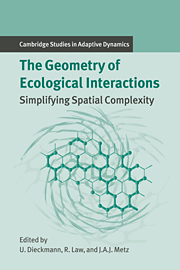Book contents
- Frontmatter
- Contents
- Contributing Authors
- 1 Introduction
- Part A Empirical and Statistical Background: A Plant Ecological Perspective
- Introduction to Part A
- 2 A Neighborhood View of Interactions among Individual Plants
- 3 Spatial Interactions among Grassland Plant Populations
- 4 Spatio-temporal Patterns in Grassland Communities
- 5 Statistical Modeling and Analysis of Spatial Patterns
- Part B When the Mean-field Approximation Breaks Down
- Part C Simplifying Spatial Complexity: Examples
- Part D Simplifying Spatial Complexity: Techniques
- References
- Index
- International Institute for Applied Systems Analysis
5 - Statistical Modeling and Analysis of Spatial Patterns
Published online by Cambridge University Press: 14 January 2010
- Frontmatter
- Contents
- Contributing Authors
- 1 Introduction
- Part A Empirical and Statistical Background: A Plant Ecological Perspective
- Introduction to Part A
- 2 A Neighborhood View of Interactions among Individual Plants
- 3 Spatial Interactions among Grassland Plant Populations
- 4 Spatio-temporal Patterns in Grassland Communities
- 5 Statistical Modeling and Analysis of Spatial Patterns
- Part B When the Mean-field Approximation Breaks Down
- Part C Simplifying Spatial Complexity: Examples
- Part D Simplifying Spatial Complexity: Techniques
- References
- Index
- International Institute for Applied Systems Analysis
Summary
Introduction
This chapter deals with statistical methods for the analysis and interpretation of empirical data. It covers three main subjects: essentially descriptive statistical methods, the development of stochastic models, and more formal statistical methods interrelating the models with empirical data. Spatial and spatio-temporal data arising in ecology can be of many different types. We aim to give some general principles with outline illustrative examples. In Sections 5.3 and 5.4, we concentrate largely on observations in the form of sets of points in space and time (for example, animals or plants of a particular species).
Systems and data under study may be classified in numerous ways (e.g., Figures 4.1 to 4.3). For example, they may be based on quadrat counts – that is, sums or integrals over finite areas – or on essentially continuous observation in space, or sampled at a discrete grid of points in space or along line transects. Similarly, data may be observed in continuous time or aggregated over time intervals, or they may be sampled at discrete time points, such as yearly intervals. The analysis may concentrate on a single feature of interest or, more commonly, on the interrelationships between different features, for instance, on the interdependence of different species or on the dependence of one or more features on explanatory variables. Data may be observed at one time point and several or many spatial positions, or may be replicated in time as well. For simplicity of exposition, however, in Section 5.2 we deal briefly with data replicated only in time (see Section 5.2, Descriptive time series analysis).
- Type
- Chapter
- Information
- The Geometry of Ecological InteractionsSimplifying Spatial Complexity, pp. 65 - 88Publisher: Cambridge University PressPrint publication year: 2000
- 1
- Cited by



